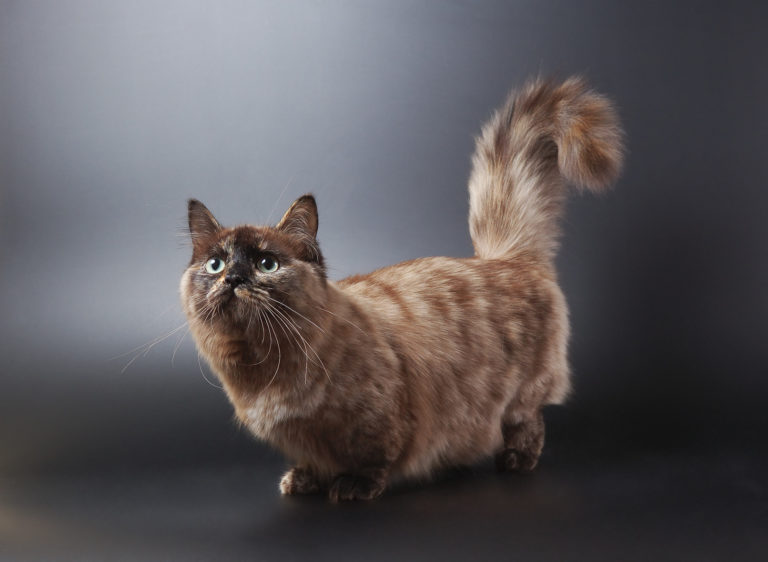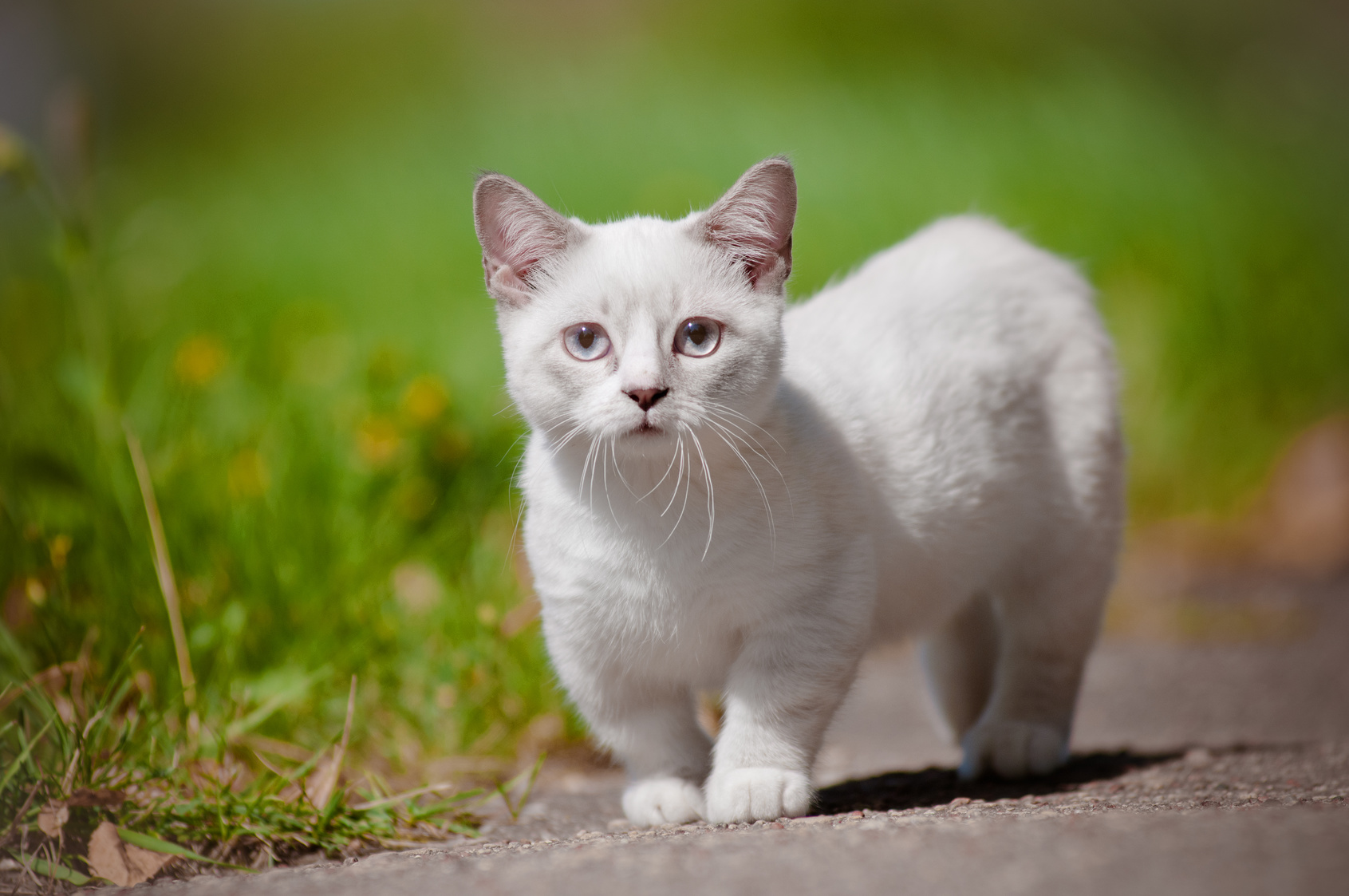Maine Coon
The Maine Coon has become one of the most popular cat breeds in the world. This is probably due to its majestic appearance, robust nature and great character.
This unique-looking breed of cat comes from the US and is still rare elsewhere. Its characteristic short legs are the result of a random genetic defect. Together with its distinctive nature, this exact characteristic makes the Munchkin cat so special in the eyes of its breeders and fans.

© KaterinaCherkashina / stock.adobe.com
Munchkin cats were discovered as early as the start of the 20th century, though they were forgotten during the Second World War. The Munchkin later appeared in Volgograd, New England and finally Louisiana in the 1980s, where Sandra Hochenedel discovered a small black cat with short legs. She named the kitten Blackberry. Blackberry gave birth to numerous kittens and half of each breed was also short-legged. Toulouse, a male from one of Blackberry’s litters, was given to a female friend of Sandra Hochenedel. These two cats formed the foundation of the Munchkin breed.
In 1991, Munchkin cats were first exhibited in New York in Madison Square Garden and in 1994 were registered in the breeding programme of the TICA (The International Cat Association). The breed gained Championship Status in 2003. Several renowned breeding associations don’t recognise the Munchkin, such as the FIFe (Fédération Internationale Féline). It’s claimed that the Munchkin came about from a hereditary disease or that the breed tends to have health problems due to its deformed legs. However, many Munchkin breeders and vets believe that Munchkins are in no way limited or more susceptible to health issues than other cat breeds.
The name Munchkin relates to the small Munchkin people from Fleming’s “The Wizard of Oz” (1939).
The Munchkin’s legs draw the attention and are strikingly short in relation to the body. They are considered to be trademark of these cats, though at the same time are strong and muscular. Their ears are disproportionately large, point straight upwards and are slightly rounded at the tips. Their heads are wedge-shaped, their almond-shaped eyes are set wide apart and are slightly at an angle. Their eyes come in all colours.
The Munchkin’s legs should be the same length, though the the hind legs are somewhat longer. The paws point forwards rather than inwards or outwards and are rounded. The tail is as long as the body and slightly rounded at the end.
Munchkins are medium-sized to large with a very muscular frame. Munchkin females tip the scales at only 2 to 3.5kg, while males weigh 3 to 4kg.
There are short-haired and long-haired Munchkins (Munchkin Longhair). The short and very plush fur of short-haired Munchkins or medium-length, silky fur (semi-long hair) lies flat on the muscular body. Munchkins come in all imaginable colours, from black and white to grey and ginger and they can have many different markings. The eye colour can also vary.
In addition, there are also sub-breeds of the Munchkin cat. One of these is the dwarf-like Mei Toi. Some short-legged varieties described as “super-short” are also already known.
Its character is described as cuddly and calm, yet at the same time very sociable as well as lively and playful. Munchkins have just as great a need for activity as other cats, which is in the medium to high range. They are able to jump despite their short legs, though not as high as other cat breeds. Nevertheless, their short legs don’t limit their mobility. Their speed is remarkable and they also love to climb, meaning that a cat tree is indispensable in a cat owner’s household.
Normally, Munchkins get on very well with children, other cats and other pets in general. They love it when their human gives them lots of love, affection and positive attention and like to be part of as many aspects of their daily life as possible. Munchkins are very interested in family life and love to take part due to their curious nature, for which they are well-known. They often stand on their hind legs in order to get a better view of things.
For this reason, a Munchkin cat should not be kept in a household where it would be left alone all day. A household with older people who have lots of time to spend with their beloved pet is ideal. Also, a family with children, other cats or pets would suit the character of the Munchkin – provided of course that the children treat the kitty in a considerate and responsible way.
 © otsphoto / stock.adobe.com
© otsphoto / stock.adobe.com
The Munchkin cat is not well suited to being kept as an outdoor cat and ultimately finds itself limited in the outdoors in contrast to other breeds that happily jump around. Access to a secured outdoor area can be a good compromise.
Depending on how long the fur is, you should brush your feline friend’s coat regularly. This will prevent the fur from getting matted. Aside from this, regularly grooming your cat with a brush strengthens the bond between the two of you. Last but not least, your precious sofa will be kept free of cat hair. Every household that has a cat should also have a scratching post. Munchkin cats also like to use them to keep their claws sharp and in good condition.
Caring for the teeth goes hand in hand with diet when it comes to cats. Dry cat food is very effective here. Very rarely might it be necessary for your trusted vet to help out.
On the subject of the vet, it is recommended that you pay a visit once or twice a year. The vet has all the info on deworming and vaccinations for your cat. Good nutrition and preventative measures and so forth can help to avoid lengthy and expensive interventions from the vet and will spare your beloved pet any pain.
According to an assessment by ‘The International Cat Association’ (TICA), the short legs don’t cause any restrictions to the cat’s ability to move around, contrary to the opinion of critics.
Since the Munchkin is a relatively new breed, there is still no concrete information about diseases specific to the breed.
That said, cats from this unique breed are sometimes diagnosed with lordosis. This is described as an inward curve of the spine. Animals that are affected by lordosis often die at a young age. Whether the disease is connected to the short legs is unclear. In contrast to the Dachshund dog, which is also known for its short legs, the Munchkin doesn’t tend to have problems with its spine.
Munchkins can live to be 18 years of age if they are kept and fed in a species-appropriate manner.
Dry food has advantages, particularly for the owner of the cat. It doesn’t produce any smell and the cat can help itself at any time, for example, when its owner is at work. Mind you, it should only be an addition or offered as a variation to wet food in the best interests of the cat. Only in this way can a balanced diet be guaranteed. Dry food can be criticised for only containing a little water, around just eight percent. This doesn’t correspond to the natural eating habits of cats, as they regulate their liquid intake through their food in the wild. If a cat only consumes dry food, this can lead to kidney and bladder diseases. In addition to this, dry food has a high calorie density and can lead to weight gain. On the other hand, some vets recommend a diet based on dry food – provided it is of a high quality.
Cats would probably choose to buy wet cat food, as it corresponds more to their natural eating habits. Be especially careful about the correct composition of meat and vegetables. Good brands can be recognised by the fact that all processed animal by-products are listed clearly. This transparency creates trust. Offal such as liver, heart and stomach is considered to be high-quality. A maximum of two to five percent of the content should come from plants.
BARF, which stands for biologically appropriate raw feeding, is also worth recommending.
As we know, cats are carnivores by nature and their diet should of course take this into account. BARF corresponds to the instinct, metabolism and anatomy of a cat. It is based on the eating habits of the wild ancestors of today’s domestic cats. BARF offers many advantages. It keeps the teeth healthy and prevents the build up of plaque, as well as food allergies and liver problems. It guarantees high quality, fresh food, high nutritional value and avoids chemical and synthetic additives.
Munchkins are predominantly bred in the US, so getting hold of one isn’t particularly easy. Responsible breeders can be found in isolation, though you should be willing to travel some distance. The price of a Munchkin is between 300 and 1,500 US dollars.
Make sure to choose a serious breeder who treats their animals responsibly. Kittens should stay with their mother for at least 12 weeks after being born in order to learn all the feline essentials. Steer clear of breeders who offer pedigree cats for bargain prices with no paperwork. It’s rare to find Munchkins in animal shelters, though perhaps the very cat of your dreams awaits you there. So visiting an animal shelter is definitely worthwhile!
| Size | Medium |
| Nickname | Sausage Cat |
| Weight (Females) | 2-3.5 kg |
| Weight (Males) | 3-4 kg |
| Coat | Two Lengths: Short and soft, or medium and silky |
| Coat Color | Many variations: white, black, gray, red, with various markings |
| Recognition | Not recognized by all cat associations (e.g., FIFe) |
| Temperament | Sociable, playful, affectionate, bonds with family |
| Price | Up to 1000 euro |
| Health | No known recurring genetic conditions, may be more prone to lordosis (curvature of the spine) |
| Lifespan | 12-18 years |
| Tendency to Meow | Varies |
| Good with Children | Yes |
| Good with other Pets | Yes |
| Apartment Living | Yes |
| Hypoallergenic | No |
Here are some purchase proposals curated by the zooplus editorial team
The products featured have been carefully selected by our editorial staff and are available at the zooplus online pet shop. The selection does not constitute advertising for the mentioned brands.
The Maine Coon has become one of the most popular cat breeds in the world. This is probably due to its majestic appearance, robust nature and great character.
Large eyes and attentively upright ears instantly tell you a great deal about this charming breed of cat: Abyssinians are inquisitive and affectionate towards people.
With its long, dense fur, rounded ears, and intense stare, the Pallas Cat, or Manul, looks rather fluffy, yet somewhat dangerous. However, don't be fooled by its appearance—this is no petting zoo resident. The Manul is a wild animal and considered untameable.